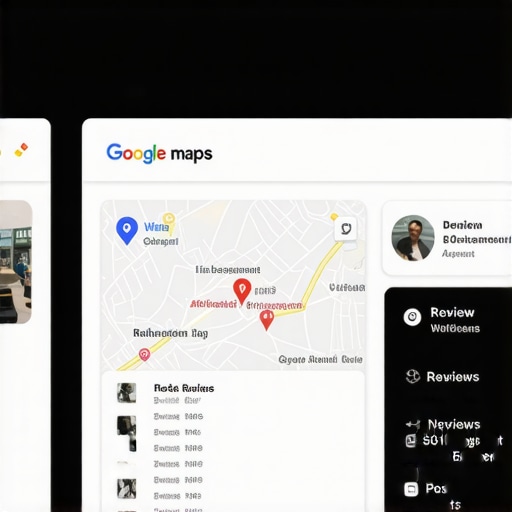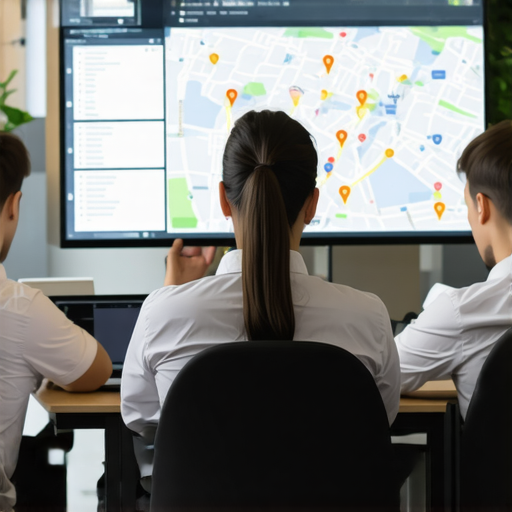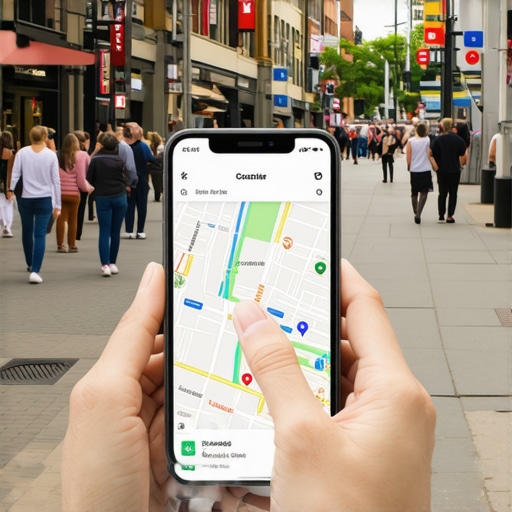My Journey into Google Maps Optimization: From Frustration to Success
Not long ago, I was struggling to get my local business noticed on Google Maps. Despite having a great product, I just couldn’t seem to crack the code for higher visibility. One day, I decided to dive deep into the world of Google Maps agency tips, and that decision transformed my approach entirely. Today, I want to share some personal insights and proven strategies that helped me boost my local rankings significantly in 2024.
Why Local SEO and Google Maps Matter More Than Ever
In my experience, optimizing for Google Maps isn’t just about listing your business; it’s about building a credible and authoritative presence that Google trusts. As I explored more, I learned that factors like consistent NAP (Name, Address, Phone number), reviews, and local relevance are critical. According to Moz, local SEO is evolving rapidly, and staying updated with the latest Google Maps agency tips is essential for success.
My Top Strategies for Google Maps Visibility in 2024
How can I leverage Google My Business (GMB) features for maximum impact?
One of the first things I did was fully optimize my GMB profile. This included accurate business details, high-quality photos, and engaging posts. I also made sure to respond to reviews promptly, which not only improved my reputation but also signaled activity to Google. According to experts at Local Map SEO Experts, consistent engagement is a core aspect of top-tier Google Maps rankings.
Are There Hidden Tricks That Actually Work?
Absolutely! I found that local backlinks and Citations play a crucial role. It might sound old-school, but building relationships with local bloggers and directories helped me enhance my map visibility. Plus, I experimented with adding relevant keywords naturally into my business description, which boosted my relevance score without risking over-optimization.
My Advice for Fellow Local Business Owners
If you’re serious about dominating local search in 2024, I recommend sticking with proven strategies and adapting to new updates. The landscape is always changing, but foundational practices like accurate NAP info, reviews, and local relevance remain constant. I also encourage you to explore comprehensive resources like Top Maps Visibility Service Strategies to stay ahead of the curve.
What’s the one thing you wish you knew when starting Google Maps optimization?
For me, it was understanding the importance of local reviews and timely responses. These small actions made a big difference. If you want to see real results, don’t overlook this crucial aspect of local SEO.
If you’ve had your own experiences or tips with Google Maps, I’d love to hear them! Drop a comment below or share this post with fellow entrepreneurs eager to boost their local presence. Remember, consistency and staying updated are your best friends in this journey.
Unlocking Google Maps Secrets: Are You Missing These Critical Optimization Techniques?
As a seasoned local SEO expert, I can tell you that staying ahead in Google Maps rankings requires a nuanced understanding of both foundational and advanced strategies. Beyond the basics like accurate NAP information and prompt review responses, there are subtle yet powerful tactics that can elevate your visibility significantly. For instance, leveraging Google Posts effectively, optimizing for voice search, and utilizing schema markup are often overlooked but highly impactful methods. According to Moz, these evolving factors are shaping the future of local search dominance.
How Does Google’s Algorithm Really Assess Your Map Listing’s Authority?
Google’s algorithm considers a complex interplay of signals—review sentiment and volume, behavioral metrics like click-through rates, and consistency across local citations. Essentially, it’s about creating a robust, trustworthy profile that signals authority. For example, regularly updating your Google My Business (GMB) profile with fresh content, responding to reviews, and maintaining consistent NAP details across all directories sends positive signals to Google. For an in-depth look at proven strategies, visit best Google Maps agency tips.
What Are the Most Effective Local SEO Tactics to Outrank Competitors?
In my experience, combining local backlinks with targeted keyword optimization in your business description creates a synergy that Google favors. Building relationships with local bloggers and participating in community events not only enhances your reputation but also generates valuable backlinks, boosting your map rankings. Additionally, utilizing schema markup helps Google understand your business details better, improving your chances of appearing in rich snippets. This comprehensive approach aligns with the strategies outlined by Map SEO Experts.
Are You Maximizing Google Maps Features to Their Full Potential?
Many local businesses overlook the power of Google Maps features like Q&A, booking integrations, and product showcases. Engaging actively with these features can increase your profile’s engagement metrics, which are increasingly weighted in Google’s ranking algorithms. For example, frequently updating your Q&A section with relevant questions and answers not only helps potential customers but also signals activity to Google, reinforcing your profile’s relevance. For a detailed guide on leveraging these features, check out GMB optimization team strategies.

Illustration of a local business profile optimized with Google Maps features like reviews, Q&A, and posts, showing high engagement levels.
What is the Next Big Shift in Google Maps Optimization for 2024?
The answer lies in the integration of AI and machine learning. Google is increasingly using sophisticated algorithms to interpret user intent and local relevance, meaning your content must be deeply tailored to your local audience’s needs. Personalization, local content marketing, and AI-driven review generation are emerging frontiers that savvy businesses are exploring now. To stay at the cutting edge, I recommend exploring recent updates from Google and industry leaders, such as the insights shared by Top Maps Visibility Service Strategies.
If you’re eager to share your experiences or ask questions about Google Maps SEO, I encourage you to comment below or share this article with fellow local entrepreneurs. Remember, continuous learning and adaptation are the keys to long-term success in local search.
Mastering the Art of Local Authority: Beyond the Basics
When I first started refining my Google Maps presence, I thought that just having accurate NAP details and gathering reviews would suffice. However, as I delved deeper, I realized that establishing true local authority requires a more nuanced approach. One technique I adopted was creating localized content that resonates with my community, such as blog posts about local events or collaborations with neighborhood influencers. This not only improved my relevance signals but also fostered genuine community trust. According to Top Maps Visibility Service Strategies, building local authority is a cornerstone for sustained ranking success, especially as Google’s algorithms become more sophisticated.
How Can I Leverage Advanced Schema Markup for Better Visibility?
One aspect that truly transformed my approach was implementing advanced schema markup, particularly LocalBusiness schema. This helps Google better understand my offerings, hours, and service areas. I experimented with adding structured data for products, FAQs, and even event info, which contributed to enhanced rich snippets in search results. The process was initially complex, but tools like Google’s Structured Data Markup Helper made it manageable. For those serious about outpacing competitors, exploring schema markup on your site and in your GMB posts can create a significant edge. For a comprehensive guide, check out GMB optimization strategies.
What Are the Nuanced Signals That Google’s Algorithm Uses to Assess Authority?
Over time, I learned that Google’s evaluation of your local authority isn’t solely about reviews and citations. Behavioral metrics such as click-through rates, time spent on your profile, and engagement with your posts subtly influence your ranking. Additionally, Google increasingly values consistency and freshness—regularly updating your profile with new photos, offers, or posts signals activity and relevance. I found that integrating automated review requests and engaging local audiences through social media also boosts these behavioral signals. A recent study by Moz highlights that these dynamic signals are becoming more integral to local ranking algorithms, making ongoing engagement vital.
Is There a Way to Harness Voice Search for Local Visibility?
Yes, and this is where my experience took an interesting turn. With voice search becoming more prevalent, optimizing for natural language queries has gained importance. I started incorporating conversational keywords into my content and FAQ sections—phrases people naturally speak rather than type. For example, instead of just “best pizza near me,” I added “Where can I find the best pizza around here?” This required a shift in content creation, but it paid off as voice searches often trigger Google Maps results directly. To stay ahead, I recommend reviewing your content with voice search in mind and using tools like Answer the Public to identify common spoken queries relevant to your local area.
What’s the Most Overlooked Yet Crucial Aspect of Long-Term Google Maps Success?
In my journey, I’ve found that maintaining consistency and authenticity is often overlooked. Businesses tend to focus on quick wins, but long-term success hinges on genuine engagement and staying true to your community. This means responding to reviews thoughtfully, participating in local events, and continuously updating your profile with meaningful content. The landscape is ever-changing, but foundational dedication and authentic interactions create a resilient local presence. If you’re eager to deepen your understanding, exploring detailed strategies at best Google Maps agency tips can provide valuable insights.
If you’ve experimented with advanced tactics or have personal stories to share, I invite you to leave a comment below. Your experiences could inspire others on their journey to local SEO mastery. Remember, in this field, continuous learning and authentic engagement are your best allies.
Harnessing Local Authority Through Community-Centric Content
Building upon my earlier insights, I realized that establishing genuine local authority requires more than just technical adjustments; it demands a community-centric approach. Creating localized content that resonates deeply with your neighborhood fosters trust and signals authenticity to Google. For instance, sharing stories about local events, collaborations with community influencers, or highlighting regional success stories can significantly enhance your relevance signals. This strategy aligns with the principles outlined in Top Maps Visibility Service Strategies, emphasizing that long-term authority stems from authentic local engagement.
Maximizing Schema Markup for Richer Local Search Results
Implementing advanced schema markup has been a game-changer in my optimization efforts. Beyond basic LocalBusiness schemas, integrating structured data for FAQs, products, and events can unlock rich snippets that dramatically improve visibility. I found that tools like Google’s Structured Data Markup Helper streamline this process, making it accessible even for those new to schema. Properly formatted schema not only helps Google understand my offerings better but also increases the likelihood of appearing in prominent search features. For comprehensive guidance, I recommend exploring GMB optimization strategies.
Deciphering Google’s Authority Assessment: Beyond Reviews and Citations
Over time, I uncovered that Google’s assessment of local authority involves a complex array of signals. Behavioral metrics such as click-through rates, time spent on your profile, and engagement with your posts increasingly influence rankings. Moreover, consistent updates—like fresh photos, new offers, and active Q&A sections—signal ongoing relevance. Incorporating automated review request systems and engaging audiences via social media platforms further amplifies these signals. As Moz highlights, these dynamic behavioral signals are becoming central to Google’s local algorithm, making continuous engagement essential.
Optimizing for Voice Search: Embracing Natural Language Queries
My exploration into voice search optimization revealed its potential to dramatically boost local visibility. I started embedding conversational keywords into my content and FAQ sections, reflecting how people naturally speak. For example, replacing generic queries like “best pizza near me” with more natural phrases such as “Where can I find the best pizza around here?” proved effective. This shift required a nuanced approach to content creation but paid dividends, especially as voice searches often directly trigger Google Maps results. To capitalize on this trend, I recommend reviewing your content with an ear for natural speech patterns and leveraging tools like Answer the Public for common spoken queries relevant to your locality.
Engaging with Google Maps Features for Enhanced User Interaction
Many local businesses overlook the full potential of Google Maps features. Active participation in Q&A, updating product showcases, and integrating booking functionalities can significantly boost your profile’s engagement metrics. For instance, regularly updating the Q&A section with relevant questions and answers not only assists potential customers but also signals activity to Google, reinforcing your relevance. This ongoing interaction aligns with insights from GMB optimization tips, emphasizing that engagement metrics are increasingly influential in ranking algorithms.
The Future of Local SEO: AI Integration and Personalization
Looking ahead, AI and machine learning are poised to revolutionize local SEO. Google’s algorithms are becoming adept at interpreting user intent and local relevance, which means your content must be highly personalized. I recommend adopting AI-driven review generation tools and local content marketing strategies that cater to specific community needs. Staying updated with the latest industry insights from sources like Top Maps Visibility Service Strategies is crucial to remain competitive in this evolving landscape. Embracing these advanced techniques can position your business at the forefront of local search innovation.
Inviting Your Insights and Experiences
If you’ve experimented with these advanced tactics or have unique insights into Google Maps optimization, I invite you to share your experiences. Engaging in a community of like-minded professionals not only enriches your understanding but also opens avenues for innovative collaboration. Drop a comment below or connect with me through my preferred channels—your stories could inspire others to elevate their local SEO game. Remember, continuous learning, authentic engagement, and strategic innovation are your best tools for sustained success in this dynamic field.
Things I Wish I Knew Earlier (or You Might Find Surprising)
The Power of Community Engagement
Early in my journey, I underestimated how much genuine community engagement could influence my Google Maps rankings. Building real relationships with local customers and participating in neighborhood events created trust and authenticity that Google could sense, boosting my visibility more than I expected. It’s like planting seeds; the more you nurture local ties, the richer your growth.
Why Consistency Trumps Quick Fixes
Initially, I chased after quick wins—rapid reviews or sudden keyword spikes—thinking they’d catapult my rankings. But I soon realized that steady, consistent updates to my Google My Business profile, regular posting, and review management created a lasting impression. Google favors persistence over shortcuts.
The Untapped Potential of Schema Markup
I was surprised to learn how much implementing structured data, especially LocalBusiness schema, could enhance my profile’s appearance in search results. Rich snippets with ratings, FAQs, or event info added credibility and caught more eyes, leading to more clicks and visits. It’s a technical step worth investing time into.
Voice Search Is Changing the Game
Adapting my content for voice search—using natural language and conversational keywords—opened new doors. People speak differently than they type, so optimizing for spoken queries helped my business appear in voice-activated Google Maps results. This shift pushed me to think more about how my community naturally asks questions about local services.
The Significance of Behavioral Signals
Over time, I noticed that factors like click-through rates and time spent on my profile played a crucial role. Engaging content, prompt responses, and active updates encouraged visitors to stay longer and interact more, signaling Google that my listing was relevant and trustworthy. This insight changed how I approached my daily management.
Aligning with Google’s Future Trends
I keep an eye on emerging trends like AI-driven personalization and local content marketing. Google’s algorithms are becoming smarter at interpreting user intent, so tailoring my content to local needs and leveraging AI tools for reviews and suggestions helps me stay ahead in 2024 and beyond. The future is about personalization and authenticity.
Resources I’ve Come to Trust Over Time
- Moz: Their comprehensive local SEO checklists and updates have been invaluable for understanding the evolving landscape of Google Maps optimization. I recommend it to anyone serious about staying current.
- Google’s Structured Data Markup Helper: A fantastic tool that simplified implementing schema markup, making my rich snippets more effective and easier to manage. It’s a must-try for local businesses aiming for enhanced visibility.
- Local Map SEO Experts: Their insights into top strategies and updates on Google’s algorithm changes kept me informed and adaptable. Their resources are reliable and practical.
Parting Thoughts from My Perspective
If there’s one thing I’ve learned about Google Maps optimization in 2024, it’s that a holistic, community-focused approach combined with technical savvy yields the best results. Building trust through authentic engagement, maintaining consistency, and embracing new trends like schema markup and voice search can truly elevate your local presence. Remember, SEO isn’t just about algorithms; it’s about connecting with your community and providing value. If this resonates with you, I’d love to hear your thoughts or experiences. Share this article with fellow entrepreneurs, and let’s grow together in this ever-evolving landscape of local SEO!


This post really hits home for me, especially the part about community-centric content. I’ve seen firsthand how storytelling about local events and collaborations can boost not just Google Maps rankings but also genuine engagement with the community. I’ve started producing local-focused content, such as highlighting neighborhood stories, and the response has been encouraging. That said, I often wonder about balancing local relevance with broad SEO practices—how have others managed to keep content both community-specific and optimized for wider search traffic? Also, I’d love to hear more about how schema markup has worked for those trying to enhance their local snippets. For me, implementing FAQs with schema has helped in appearing in richer search features, but I’m curious if anyone has tips on optimizing proprietary features like Google Posts effectively? Would be great to exchange more insights on keeping content fresh and authentic while also leveraging the latest technical strategies.